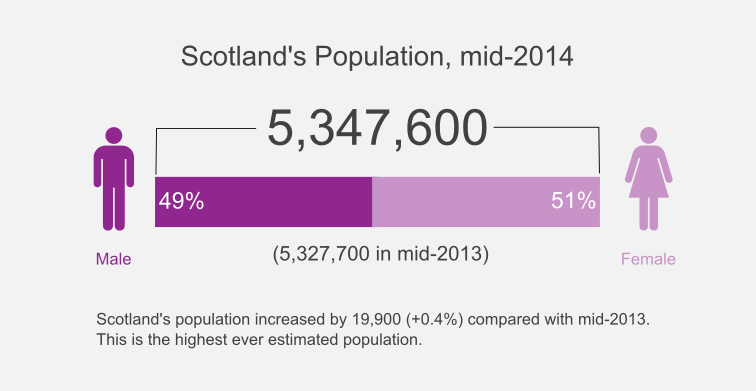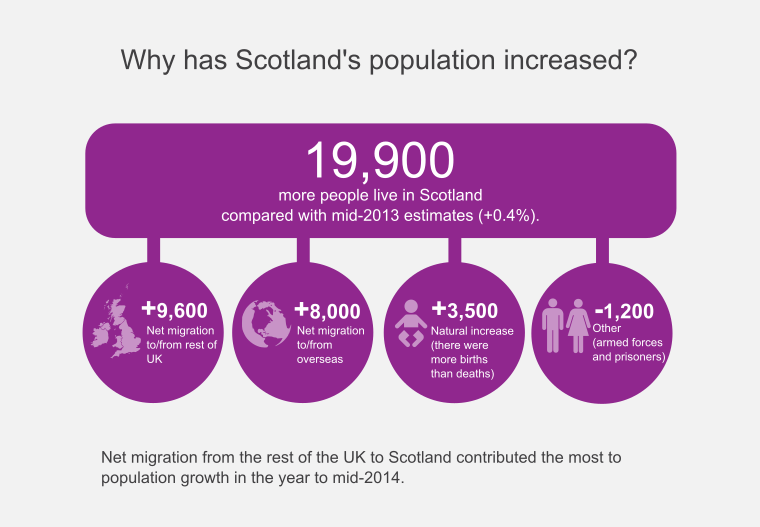Scotland's Population at its Highest Ever
Scotland's Population at its Highest Ever

Scotland’s population continues to rise and reached its highest ever total in 2014.
Statistics published today by the National Records of Scotland (NRS) show that the estimated population of Scotland was 5,347,600 in mid-2014.
The figures show a rise of 19,900 (0.4 per cent) people since mid-2013, as shown in the following infographic:

The population increased because approximately 3,500 more people were born than died, and because in-migration which includes people from the rest of the UK exceeded out-migration by approximately 17,600 between mid-2013 and mid-2014. Other changes, such as in armed forces and prisoners, resulted in a loss of approximately 1,200 people. This is illustrated in the following infographic:

Between mid-2013 and mid-2014, approximately 49,240 people came to Scotland from the rest of the UK, and approximately 39,660 left Scotland to go in the opposite direction, giving a net migration gain of approximately 9,600.
Between mid-2013 and mid-2014, 33,200 people came to Scotland from overseas and 25,200 left Scotland to go overseas giving a net migration gain of 8,000, which represents about 1 in 700 (0.14 per cent) of the total population.
Other key facts:
Migrants to Scotland tended to be younger than the general population
- Over two thirds of migrants from overseas and nearly half of migrants from the rest of the UK were aged 16-34 years. In the population as a whole, only a quarter were in this age group.
- Only seven per cent of people coming to Scotland from the rest of the UK and one per cent of people entering from overseas were aged 65 and over. Scotland had a net gain of UK migrants in every age group and a net loss of international migrants for the majority of migrants aged over 45.
The average age of Scotland’s population was lower in the big city areas than in more rural Council areas
- The median age (the age at which half the population is older and half is younger) of the population in Scotland was 41.
- The median age was lower in big city areas (35 in Glasgow City and 36 in Aberdeen City and the City of Edinburgh) than in more rural Council areas (47 in Argyll & Bute, Dumfries & Galloway, Eilean Siar, Scottish Borders and South Ayrshire).
The population in 23 Council areas has increased while in nine Council areas the population has decreased
- Between mid-2013 and mid-2014, Midlothian had the largest percentage population increase at +1.8 per cent, followed by Aberdeenshire and Edinburgh City (+1.1 per cent) and East Renfrewshire (+1.0 per cent). Inverclyde had the largest percentage population decrease at -0.6 per cent, followed by Eilean Siar (-0.5 per cent) and Argyll & Bute (-0.4 per cent).
- The populations of Aberdeenshire and the City of Edinburgh increased because of more births than deaths and because of net in-migration. (The populations in Midlothian and East Renfrewshire increased primarily because of net in-migration). In contrast, the populations of Inverclyde, Eilean Siar and Argyll & Bute decreased because of more deaths than births and because of net out-migration.
- On average, in mid-2014 there were 69 people per square kilometre in Scotland, ranging from nine people per square kilometre in Eilean Siar and Highland to 3,433 people per square kilometre in Glasgow City Council area.
The full publication Mid-2014 Population Estimates Scotland is available on this website.
An infographic supplement is available for this publication on this website.